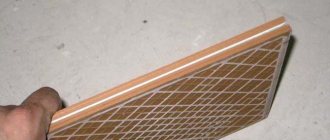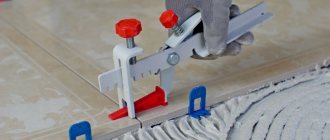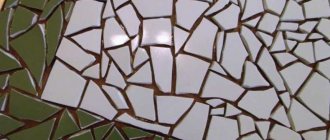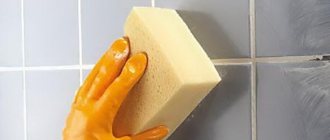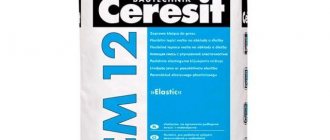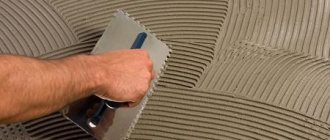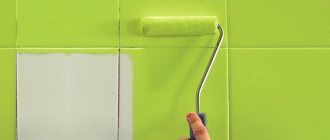During repair work, situations often arise when, quite accidentally, the primer solution or grout gets onto the surrounding surfaces. You can stain tiles, flooring, walls or a metal-plastic window. This problem requires an immediate solution due to the characteristics of the primer. Thanks to its chemical and physical properties, it penetrates to a depth of up to 10 cm and reliably holds materials together. This creates difficulties if it accidentally gets on the windowsills or floor.
Why is primer difficult to remove?
I use primer to fill voids and uneven areas. Among its features is that after it dries completely, it becomes insoluble and resistant to many physical and chemical influences.
For this reason, when working with primer, it is recommended to cover with something all surfaces that may receive splashes or excess mixture. Newspapers, masking tape, cellophane, etc. are suitable for this.
What is primer and what is it used for?
Treating surfaces with a primer is considered preparatory work before final finishing. It is a highly viscous solution that forms a thin layer on the material, which is used to increase the adhesion of coatings. It contains various high quality components with film-forming properties. Modern primer is characterized by reliability, high manufacturability and a wide range on the construction market. For metal surfaces, among other things, the solution prevents corrosion and has water-repellent and antiseptic properties.
Methods for cleaning tiles from primer
If the primer gets splashed on the tiles, it is necessary to wash them off as quickly as possible with a soap solution.
If the soil has hardened, you should first try to remove it as follows:
- Dissolve stains on the tiles with a small amount of soil mixture;
- After the primer has dissolved, remove it with a dry cloth;
- Wipe the remaining stain with a damp cloth and then cover with a wet cloth;
- After a couple of hours, remove the cloth and wipe the surface with a damp cloth.
In addition to the proposed method, there are other, no less effective methods.
Additional options
When solving the problem of “how to wash off the primer” remaining on tiles with an acid-resistant glaze, you can use household acid products designed for cleaning plumbing fixtures.
You can also achieve good results with the help of the well-known “Mr. Muscle”, traditionally used in situations where you need to clean windows. With its help, you can really solve the problem with other surfaces.
However, with a rough surface, you cannot do without a hard sponge. The product is suitable for treating glazed tiles.
Traces, including those on linoleum patterns, can be thoroughly wiped off with a cloth dampened in combination with a large amount of baking soda.
Essence, concentrated vinegar, is a product that can be successfully used after one to two weeks. It allows you to clean the glass of plastic windows and window sills, toilets and washbasins.
However, the product is considered quite dangerous: it does not threaten the skin of the hands, but can cause significant damage to the lungs, causing burns to these organs. To avoid health problems, you must wear a gas mask.
An alternative to this protective equipment is a paint mask with good filters. Workwear is also highly recommended.
In some situations, it may be possible to limit yourself to a household steam cleaner.
Mechanical cleaning method
To mechanically remove hardened soil from the surface of the tile, you need to purchase a special scraper with a sharp, replaceable blade from a hardware store.
Then you need to act in the following order:
- Moisten with soapy water and cover the contaminated area with a wet cloth. Leave to soak for at least 6 hours;
- Due to the possibility of damaging the tile surface, the scraper should be handled carefully. Movements should be slow and smooth;
- Sprinkle the remaining stain with baking soda and wipe with a damp sponge;
- After removing the stain, clean the tiles from soda.
This method is not suitable for tiles, which are more vulnerable to scratches.
The use of potent compounds
The need to use potent compounds arises when removing dried stains. Several chemical solutions have become popular in the market.
Veroclean
Veroclean is highly effective and produces minimal foam. Residues of raw materials can be removed through short-term exposure. Veroclean is only used on waterproof surfaces.
Powerflix
Powerflix, based on phosphoric acid, does not damage the coating and dissolves building material residues. When using the composition, it is important not to allow it to dry out. It is recommended to ventilate the room well during and after work.
Hodrupa
Low foaming Hodrupa cleaner is used on water- and alkali-resistant coatings. The product cleans raw material residues and does not lead to corrosive destruction
Atlas Zsop
Atlas Zsop is suitable for removing dried residues and dirt after repairs. The product can be used on the outside and inside of buildings. Due to the presence of inorganic acid, it is not recommended to use Atlas Zsop to clean primer marks on enamel and marble.
Dopomat
Dopomat fast-acting cleaner is designed for treating floor coverings. The product abundantly wets the surface and does not leave foam or streaks. Dopomat is suitable for cleaning after renovation and for everyday use.
Corvette
Corvette's highly alkaline solution penetrates into porous structures and removes residue from waterproof tile surfaces. After treatment, mechanical cleaning of contaminants is required.
Mister Muscle
Mister Muscle contains organic solvents that effectively remove traces of raw materials. The product can be used on almost any type of surface.
Special acids for cleaning tiles
Substances created on the basis of inorganic acids. This method of removing soil is very effective, but can only be used to remove soil from the surface of tiles that are resistant to acids. Most types of tiles under the influence of such substances will lose their appearance and begin to collapse.
- When working with acids, it is important to use personal protective equipment. The room must be well ventilated due to the risk of vapors released by the substance entering the respiratory system. It is necessary to use goggles, a respirator and rubber gloves.
- Before carrying out work, the substance must be diluted with water. Depending on the type of substance, the proportions may differ. Typically, the manufacturer indicates the optimal proportions for mixing the substance with water on the product packaging.
After diluting the solution, it is applied to the hardened soil. During action, the liquid may hiss and bubble, this indicates that the acid is successfully coping with its tasks.
After a certain period of time, the hissing stops, which indicates that the dissolved soil can be washed off. Residues should be cleaned with a baking soda solution.
In some cases, a solution of citric acid will help remove frozen soil. The stain is treated with a sponge soaked in this solution. This method is safer, but may be less effective.
How not to damage tiles during renovation
Protecting your flooring is the best way to prevent contamination during renovation work. You can use plastic film, old wallpaper, newspapers. They cover the floor in the room being renovated. An additional piece of film is spread under the container with the prepared primer composition.
After finishing the work, the covering material, splashed with the mixture, is carefully rolled up and taken out of the room. The container with the remaining solution is tightly closed with a lid.
Preventing the appearance of contaminants will eliminate the labor-intensive cleansing process. Will save time, nerves and money.
Solvents for cleaning tiles
For tiles that are vulnerable to substances that contain inorganic acids, it is possible to use organic solvents. This method is one of the most effective. Solvents are excellent at destroying soil within a few minutes.
To clean the tiles from the primer, you can use solvents such as:
- Petrol;
- Acetone;
- Turpentine;
- Toluene;
- Ethyl acetate;
- Solvent P-646.
To quickly and completely remove contamination, it is important to adhere to the following procedure:
- Moisten a cloth with the selected solvent and place it over the contaminated area;
- After a few minutes, the fabric can be removed;
- Remove the dissolved mixture with a sponge or cloth;
- After carrying out work, thoroughly wash the treated area with soapy water.
How to remove primer from windows
To wash the primer from glass without scratches, you need to use special products. The use of scrapers and detergents that contain large particles is prohibited. It is more difficult to wash stains when they are in an inconvenient location.
You can wash the surface without leaving marks, following all the rules.
Remedies to resolve the problem:
- water;
- solvent – acetone, white alcohol, flammable liquid;
- detergents that can wash dried primer - gel, liquid soap;
- soda;
- vinegar;
- a sponge with a hard and soft side, a regular dishwasher will do;
- dry rag;
- paper towels.
Effective ways to remove stains from tiles and windows:
- The procedure must be carried out within 10 minutes after the material hits the glass. Soak a cloth in water and apply it to the primer.
- Silicone scraper. Using a spray bottle, apply the product to the glass. Wait 10 minutes. You can remove dirt from the glass using a heated spatula at an angle of 30-40 degrees. There is no need to press hard on the tile.
- Mr. Apply Muscle to the balcony door or frame and leave for 5 minutes. Remove residues with a silicone scraper or cloth.
- Fresh primer. Spread the freshly prepared mixture evenly in a thin layer over the area of the dried stain. After 10 seconds, wipe with a cloth soaked in soda or vinegar.
After the procedures, it is necessary to ventilate the room so that the toxic fumes evaporate without poisoning the body.
Detergents
If none of the previous options for cleaning the tiles from the hardened primer should use strong detergents.
The product is selected taking into account the tile’s resistance to acids and its characteristics. An incorrectly selected substance can contribute to the destruction of the tile structure.
Eye and respiratory protection should be worn when removing primer stains. It is also necessary to use thick, rubber gloves and avoid contact of the substance with bare skin. The room in which the tiles are cleaned should be well ventilated.
Industrial cleaning products
When choosing products that can wash off dried primer, you need to pay attention to the resistance of the tile coating to aggressive substances. If it is not able to withstand acid treatment, it remains to use alkaline compounds or universal cleaners for different surfaces.
The instructions for use of primers often indicate the most suitable cleaning agents.
Of the household chemicals available on the market, the following are suitable for removing dried soil on tiles:
- Atlas Szop cleaner . This liquid is capable of washing away dried stains from soil, cement, paint and plaster. Contains organic acid.
- Cleaning products for plumbing fixtures and surfaces . Mr Muscle is considered the best.
- Paint removers . Most of them do not contain concentrated acids, so they can be used on all types of floor tiles.
- Cleaning agent for metals and glass “HodrupaA” . It can also be used to remove primer that has dried to the floor.
- Technical fluids – acetone, white spirit, turpentine.
If these remedies do not help, you have to use formulations based on concentrated acids and alkalis. Even deep penetration primers will be washed off under their influence. But you need to work with them with extreme caution. If handled improperly, these preparations will not only remove the dried layer, but also damage the tiled surface. In addition, they pose a health hazard.
After using any cleaner, it is necessary to rinse the treated surfaces with water. The evaporation of liquids remaining on the tiles will negatively affect the respiratory tract.
Sponges
Some types of tiles can be cleaned using special, hard sponges. They are made from special materials that can cope with hardened soil and not damage the tiles.
When working with a hard sponge, it is important to adhere to the following rules:
- Use gloves;
- Wet the sponge with cold water. Do not squeeze water onto contamination;
- Do not use chlorine-containing substances.
Removing stains from various surfaces
All of the above methods for removing primer cannot be universal. You should choose based on the type of surface being cleaned. To make an unmistakable choice, it is better to test the chosen method on a small, inconspicuous area.
Plastic
The primer is relatively easy to wash off from a plastic window sill. You can use almost any method, with the exception of solutions with acid. They can cause serious damage to plastic. It is also not recommended to use hard sponges to avoid scratches.
Even the simplest detergents effectively clean plastic. You can use vinegar essence, alcohol, or any foam cleaner. The product “Silit” performs well. Contaminants are soaked with these products and then removed with a scraper.
Polyurethane foam cleaner
The advantage of this method of cleaning tiles from primer is its versatility. This cleaner can be presented in the form of an aerosol or liquid.
In order to remove hardened soil, it is important to use a substance that has a special mark on its label. This means that the cleaner is able to remove the primer.
An aerosol is a more effective way to remove hardened primer. A small amount of aerosol is applied to the contaminated area and then removed with a sponge. The treated area is washed with water.
When working with primer, it is important not to let it come into contact with the tiles.
- It can be covered with paper, tape or cellophane.
- If excess or splashes of primer do get onto the tiles, wash the area with soap and water as quickly as possible.
- The dried mixture can only be removed using all the methods described above for removing primer from the surface of the tile.
How to Remove Fresh Primer
When renovating residential premises, dirt and construction debris appear, which must be removed throughout the entire period of work. The primer is used for finishing walls and other surfaces. When the composition dries, it cannot be removed with a scraper and is difficult to wash.
To remove the primer from the tiles, experts recommend using household chemicals.
Tiles are considered a capricious material; they are not resistant to external factors. The coating is cracked and scratched. Constant care extends its service life. Fresh dirt can be easily washed off with soapy water. To clean the smooth surface of ceramic tiles, you will need a damp sponge. Water will dissolve the uncured stain, affecting the molecules of the composition, destroying them, and will not scratch the tile. This method should be used in the first 5-10 minutes, after this time the raw material dries out.

